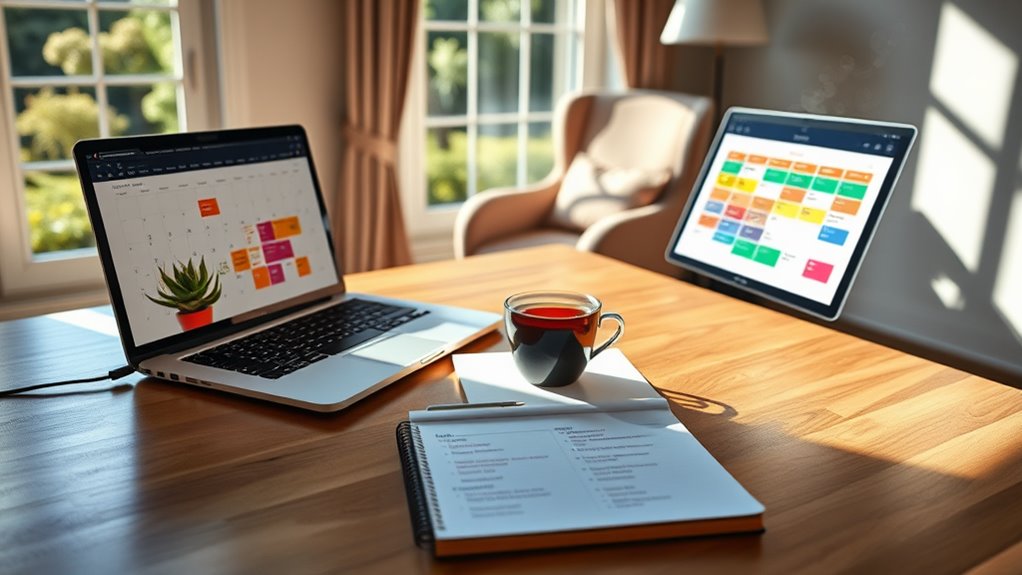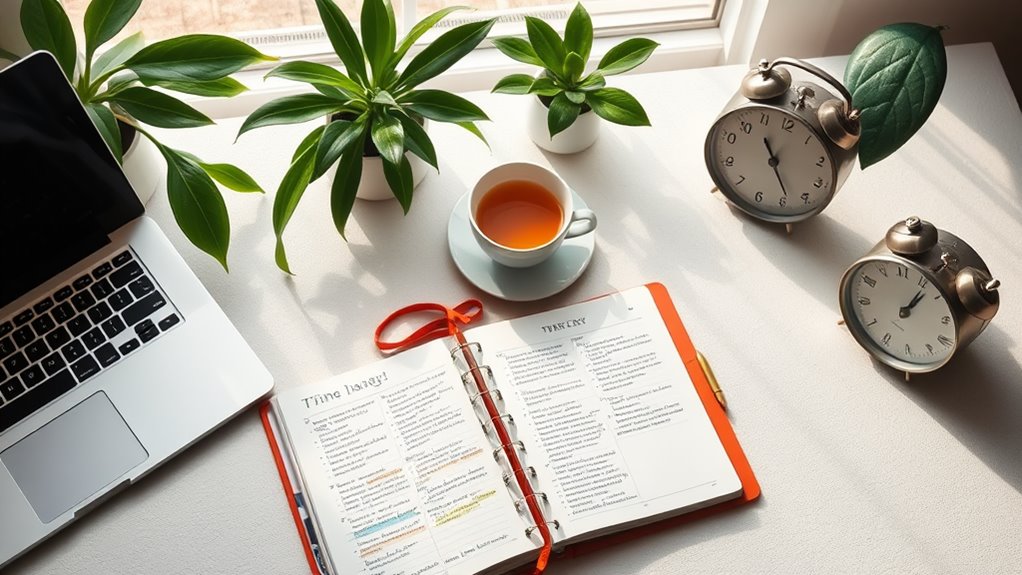Stop Wasting Time! These Tips Will Cut Your Stress in Half!
You can stop wasting time and cut your stress in half with some simple strategies! Start by identifying your time-wasting habits, like binge-watching or mindless browsing. Prioritize your tasks by focusing on what truly matters to your goals. Setting clear boundaries helps balance work and personal time, while implementing the Pomodoro Technique can boost your productivity significantly. Finally, create a daily routine to reduce decision fatigue and enhance control over your day. With these changes, you’ll feel more relaxed and efficient. And if you’re eager for more impactful tips, there’s so much more ahead for you to explore!
Identify Time-Wasting Habits
Identifying time-wasting habits is crucial for reducing stress and boosting productivity. You might not realize how much time slips away during your day-to-day activities. Start by reflecting on where your time goes. Are you scrolling through social media when you could be tackling your to-do list? It’s easy to fall into the trap of mindless browsing or binge-watching shows, but recognizing these habits is the first step toward change.
Consider keeping a time log for a week. Write down what you do every hour. This will help you pinpoint the activities that drain your time without adding value to your life. Once you see the patterns, you can take action. Maybe it’s cutting back on phone notifications or setting specific times for leisure activities.
Prioritize Your Tasks
Once you’ve uncovered your time-wasting habits, it becomes easier to see where you can make changes, especially when it comes to prioritizing your tasks. Start by listing everything you need to do, then categorize those tasks into urgent and important. Focus on what’ll have the most significant impact on your goals and well-being.
Don’t be afraid to delegate or say no to tasks that don’t align with your priorities. It’s okay to seek help! Remember, you’re not a superhero; it’s about working smarter, not harder.
Try using tools like to-do lists or digital planners to keep track of your responsibilities. Breaking larger tasks into smaller, manageable steps can also help you feel less overwhelmed and more accomplished as you check them off.
Check in with yourself regularly to reassess your priorities. Life is dynamic, and your tasks may shift. By keeping flexibility in mind, you’ll find it easier to adapt and manage stress. Prioritizing isn’t just about getting things done; it’s about creating a life that feels balanced and fulfilling. You’ve got this!
Set Clear Boundaries
Setting clear boundaries is essential for maintaining your mental health and reducing stress. When you delineate what’s acceptable and what’s not, you empower yourself to focus on what truly matters. It’s not about being harsh; it’s about self-care.
Here’s a simple table to help you visualize how to set boundaries in different areas of your life:
| Area | Boundary Example | Benefit |
|---|---|---|
| Work | Limit after-hours emails | Maintains work-life balance |
| Relationships | Say no to last-minute plans | Preserves personal time |
| Social Media | Set daily time limits | Reduces overwhelm and distractions |
| Personal Time | Schedule “me time” weekly | Enhances relaxation and recharge time |
Implement the Pomodoro Technique
The Pomodoro Technique can be a game changer for managing your time and reducing stress. This simple yet effective method helps you break your work into manageable intervals, usually 25 minutes long, followed by a short break. You’re not just working harder; you’re working smarter.
To get started, pick a task you want to tackle. Set a timer for 25 minutes and dive in without distractions. When the timer goes off, take a 5-minute break to recharge. Stretch, grab a snack, or take a quick walk—whatever helps clear your mind. After four Pomodoros, take a longer break of 15-30 minutes.
This technique encourages focus and prevents burnout, allowing you to maintain high levels of productivity while reducing anxiety. You’ll find that by committing to short bursts of concentrated work, you can tackle even the most daunting tasks with confidence. Plus, the regular breaks prevent overwhelm, making your workload feel more manageable.
Give it a try; you might be surprised at how much you accomplish while feeling less stressed. Embrace the rhythm of work and rest, and watch your efficiency soar!
Create a Daily Routine
Creating a daily routine can be one of the most effective ways to reduce stress and boost your productivity. When you establish a consistent schedule, it helps you manage your time better and minimizes decision fatigue. You’ll feel more in control of your day, which can significantly lower your stress levels.
Here’s a simple table to help you visualize how to structure your routine:
| Time | Activity |
|---|---|
| 7:00 AM | Wake up and stretch |
| 8:00 AM | Eat a healthy breakfast |
| 9:00 AM | Focused work session |
| 12:00 PM | Lunch and unwind |
Reflect and Adjust Regularly
After establishing a daily routine, it’s important to take a step back and reflect on how it’s working for you. Regular reflection isn’t just a nice-to-have; it’s crucial for reducing stress and enhancing productivity. Here are three key areas to consider:
-
What’s Working? Identify which parts of your routine are helping you feel accomplished and less stressed. Celebrate those wins!
-
What’s Not Working? Acknowledge the aspects that feel overwhelming or unproductive. It’s okay to change what doesn’t serve you.
-
How Can You Adjust? Consider small tweaks that could make a big difference. Maybe it’s shifting your work hours or incorporating brief breaks to recharge.
Taking the time to reflect and adjust can transform your routine from a source of stress into a powerful tool for well-being. You’re not stuck with the same plan forever; let your experiences guide your adjustments. Remember, it’s about progress, not perfection. By regularly checking in with yourself, you’ll create a routine that truly supports your goals and reduces stress, making your day more fulfilling and manageable.
Frequently Asked Questions
How Can I Recognize When I’m Procrastinating?
You can recognize procrastination when you feel overwhelmed or find yourself distracted by less important tasks. Notice feelings of guilt or anxiety about unfinished work; these are signals that it’s time to refocus and take action.
What Tools Can Help Me Track My Time Effectively?
To track your time effectively, you can use tools like timers, calendars, or productivity apps. They’ll help you visualize how you spend your day and identify areas to improve, making your time management more efficient.
How Do I Handle Unexpected Interruptions During Tasks?
Like a river flowing around boulders, you can navigate unexpected interruptions. Embrace them as learning moments. Take a deep breath, prioritize, and refocus. Remember, resilience in the face of chaos strengthens your productivity and peace.
Can I Apply These Tips to Team Projects Too?
Absolutely, you can apply these tips to team projects! They’ll help streamline communication and minimize interruptions, making collaboration smoother. By implementing them, you’ll not only reduce stress but also enhance productivity for everyone involved.
What Should I Do if I Feel Overwhelmed by My Tasks?
When you feel overwhelmed by tasks, take a deep breath, prioritize your to-do list, break projects into smaller steps, and tackle them one at a time. You’ve got this; just keep moving forward!





